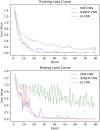A Two-stream Convolutional Network for Musculoskeletal and Neurological Disorders Prediction
- PMID: 36201114
- PMCID: PMC9537228
- DOI: 10.1007/s10916-022-01857-5
A Two-stream Convolutional Network for Musculoskeletal and Neurological Disorders Prediction
Abstract
Musculoskeletal and neurological disorders are the most common causes of walking problems among older people, and they often lead to diminished quality of life. Analyzing walking motion data manually requires trained professionals and the evaluations may not always be objective. To facilitate early diagnosis, recent deep learning-based methods have shown promising results for automated analysis, which can discover patterns that have not been found in traditional machine learning methods. We observe that existing work mostly applies deep learning on individual joint features such as the time series of joint positions. Due to the challenge of discovering inter-joint features such as the distance between feet (i.e. the stride width) from generally smaller-scale medical datasets, these methods usually perform sub-optimally. As a result, we propose a solution that explicitly takes both individual joint features and inter-joint features as input, relieving the system from the need of discovering more complicated features from small data. Due to the distinctive nature of the two types of features, we introduce a two-stream framework, with one stream learning from the time series of joint position and the other from the time series of relative joint displacement. We further develop a mid-layer fusion module to combine the discovered patterns in these two streams for diagnosis, which results in a complementary representation of the data for better prediction performance. We validate our system with a benchmark dataset of 3D skeleton motion that involves 45 patients with musculoskeletal and neurological disorders, and achieve a prediction accuracy of 95.56%, outperforming state-of-the-art methods.
Keywords: Convolutional neural network; Deep learning; Feature fusion; Musculoskeletal disorders; Neurological disorders.
© 2022. The Author(s).
Conflict of interest statement
The authors have no relevant financial or non-financial interests to disclose.
Figures











Similar articles
-
Automatic Musculoskeletal and Neurological Disorder Diagnosis With Relative Joint Displacement From Human Gait.IEEE Trans Neural Syst Rehabil Eng. 2018 Dec;26(12):2387-2396. doi: 10.1109/TNSRE.2018.2880871. Epub 2018 Nov 15. IEEE Trans Neural Syst Rehabil Eng. 2018. PMID: 30442608
-
Deep convolutional neural network and IoT technology for healthcare.Digit Health. 2024 Jan 17;10:20552076231220123. doi: 10.1177/20552076231220123. eCollection 2024 Jan-Dec. Digit Health. 2024. PMID: 38250147 Free PMC article.
-
MABAL: a Novel Deep-Learning Architecture for Machine-Assisted Bone Age Labeling.J Digit Imaging. 2018 Aug;31(4):513-519. doi: 10.1007/s10278-018-0053-3. J Digit Imaging. 2018. PMID: 29404850 Free PMC article.
-
Prevalence and Diagnosis of Neurological Disorders Using Different Deep Learning Techniques: A Meta-Analysis.J Med Syst. 2020 Jan 4;44(2):49. doi: 10.1007/s10916-019-1519-7. J Med Syst. 2020. PMID: 31902041
-
A natural evolution optimization based deep learning algorithm for neurological disorder classification.Biomed Mater Eng. 2020;31(2):73-94. doi: 10.3233/BME-201081. Biomed Mater Eng. 2020. PMID: 32474459 Review.
Cited by
-
Human Pose Estimation for Clinical Analysis of Gait Pathologies.Bioinform Biol Insights. 2024 May 15;18:11779322241231108. doi: 10.1177/11779322241231108. eCollection 2024. Bioinform Biol Insights. 2024. PMID: 38757143 Free PMC article.
References
-
- Lee, D.-W., Jun, K., Lee, S., Ko, J.-K., Kim, M.S.: Abnormal gait recognition using 3d joint information of multiple kinects system and rnn-lstm. In: 2019 41st Annual International Conference of the IEEE Engineering in Medicine and Biology Society (EMBC), pp. 542–545 (2019) - PubMed
-
- V´asquez-Correa, J.C., Arias-Vergara, T., Orozco-Arroyave, J.R., Eskofier, B., Klucken, J., Nöth, E.: Multimodal assessment of parkinson’s disease: A deep learning approach. IEEE Journal of Biomedical and Health Informatics 23(4), 1618–1630 (2019) - PubMed
-
- Abtahi M, Bahram Borgheai S, Jafari R, Constant N, Diouf R, Shahriari Y, Mankodiya K. Merging fnirs-eeg brain monitoring and body motion capture to distinguish parkinsons disease. IEEE Transactions on Neural Systems and Rehabilitation Engineering. 2020;28(6):1246–1253. doi: 10.1109/TNSRE.2020.2987888. - DOI - PubMed
MeSH terms
Grants and funding
LinkOut - more resources
Full Text Sources
Medical
Research Materials

